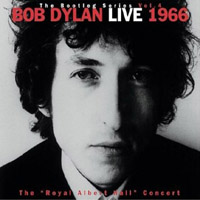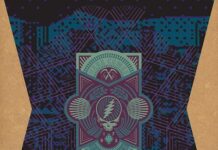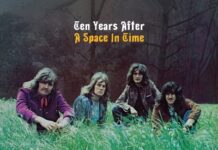Nineteen sixty-six was a pivotal year for rock n’ roll. This was when the Beatles quit touring and sequestered themselves in the studio; when blues-based groups like Cream and the Jimi Hendrix Experience unleashed their thunderous blare in London; when the Jefferson Airplane, Quicksilver Messenger and the Grateful Dead lit a psychedelic fire in the belly of San Francisco. And in the midst of all this tuning out and turning on, seminal folkie Bob Dylan decided to plug in and join the party. In 1966, Dylan made the full transformation from working-class railroad hand to post-beat hipster sporting Ray Bans and polka- dot paisleys. He still strummed his trusty acoustic and still blew his heart out on the harp. But Dylan grew tired of the political climate his songs revolved around, and he embarked on a more musical and poetic journey.
For the hardcore folkies who had supported the young Robert Zimmerman through his Greenwich Village coffee house beginnings, this was a blasphemous step. Despite the protests, Dylan went on to make his most enduring music. Over 30 years later, in the wake of Dylan’s recent Grammy-winning Time Out Of Mind, Columbia Records has gone the extra mile and dug out a real gem. Live 1966 captures the dramatic change Dylan made right on stage before a testy and belligerent audience. Dubbed The Royal Hall Concert, Live 1966 was actually recorded at the Free Trade Hall in Manchester, England on May 17. Up until now, It was considered the most sought-after bootleg in the history of bootlegs.
For anyone who has followed his career, Dylan’s shift was imminent. The Byrds were already taking his songs and injecting them with new life. The Beatles — especially John Lennon — were devout in their praise for the diminutive Minneapolis native. The Beats of San Francisco had even handed over the baton to the emerging scene of loud rock n’ roll renegades. If Dylan had continued with the folk scene, he would have drowned in a sea of electric guitars and drums. It actually started in 1965 when Dylan cut Bringing It All Back Home, an album that featured one acoustic, solo side and one electric, band side. The folkies started to twitch when the album caught on with the pop crowd. Dylan followed suit and hooked up with blues guitarist Mike Bloomfield for “Like A Rolling Stone.” When they played an impromptu set together at the Newport Folk Festival, the writing was clearly on the wall. Dylan was moving forward, with or without his audience.
As Dylan’s songs became more personal and dynamic, he assembled a permanent backing band called the Hawks, whom, years later, would blossom into The Band. In the spring of ’66, Dylan and the Hawks launched a tour of The British Isles. The battle lines were being drawn. Along with the D.A. Pennebaker’s film, Don’t Look Back, Live 1966 illustrates a case study of growth, change, contrast and the man who stood in the middle. The first CD, the acoustic/”folk” part of his show, draws heavily from Bringing It All Back Home and the yet-to-be released Blonde On Blonde. For all the controversy surrounding his new direction, Dylan could still astonish a crowd with just a guitar, a harmonica and that dreadful, yet soulful whine of his.
The songs, however, were leaps and bounds beyond the political fodder of anthems like “Blowin’ In The Wind.” Who could resist the hook of “Visions of Johanna” or “Desolation Row”? Who couldn’t be transcended by Dylan’s take on love in “She Belongs To Me” or “Mr. Tambourine Man”, already a certified “pop” hit for the Byrds.
It’s on the second CD that things start to get, in Dylan’s own summation, “weird.” During the tour — when the Hawks were brought out — people would boo, heckle, even walk out. The perfect example of this exchange between artist and audience is captured here, just before the set ends. A distinctive cat call emanates from the throng — a single word that reverberates throughout the hall: “Judas!” Dylan retorts with something along the lines of “I don’t believe you,” and the quirky ensemble immediately kicks into a stirring “Like A Rolling Stone.” It’s almost as if Big Bob is inducing his disciples to get off their duffs and accept that the times are a-really changing.
For an ancient, three-track recording, both CDs sound surprisingly crisp and clear. Robbie Robertson’s guitar work is especially bright on tracks like “Tell Me, Momma” and “Leopard-Skin Pill-Box Hat,” while Garth Hudson’s twirling Hammond organ lines virtually sing throughout “Just Like Tom Thumb’s Blues.” Along with pianist Richard Manuel, bassist Rick Danko and drummer Mickey Jones, Bob Dylan’s “Band” is a rocking unit built for both speed and comfort. In 1966, they were definitely something to behold.
As expected, the packaging for Live 1966 gets the royal treatment. A 55-page booklets spells out the details of Dylan’s metamorphosis and ultimate place in history. There are also liner notes about the recording itself — its legacy as a bootleg and eventual restoration for “official” release. Labeled as Volume 4 of the Bob Dylan Bootleg Series, Live 1966 is for anyone who ever aspired to the rebellious notion of rock n’ roll. In this case, Dylan was simply rebelling against himself.
~ Shawn Perry




















